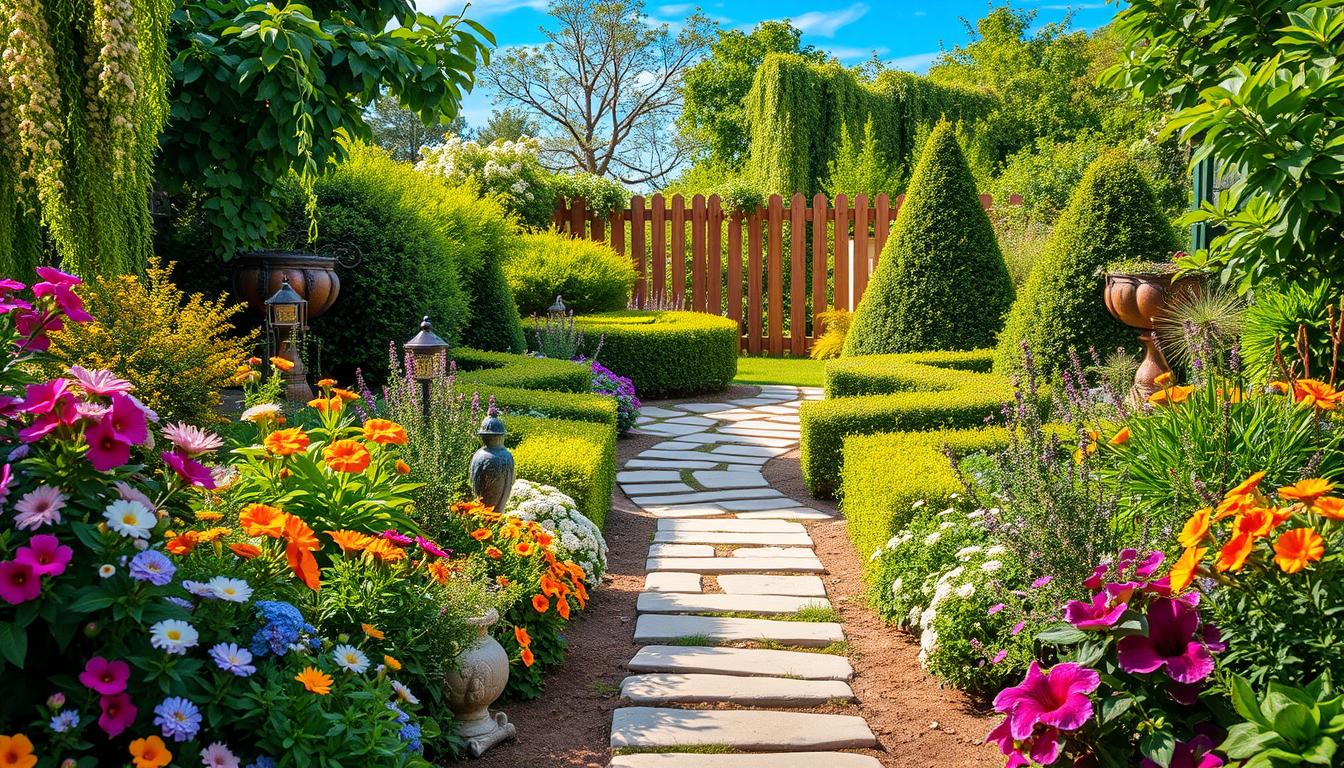Creating a stunning outdoor space can be both rewarding and transformative. Whether you’re working with a cozy backyard or a sprawling landscape, the process of crafting a beautiful yard brings joy and satisfaction. It’s not just about aesthetics—it’s about creating a space that reflects your personality and lifestyle.
Over the years, I’ve learned that a well-thought-out approach makes all the difference. From zoning and plant selection to hardscaping and seasonal adjustments, every detail matters. Eco-friendly practices are also essential, ensuring your space thrives without harming the environment. Avoiding common mistakes, like opting for plastic lawns, can save you time and effort in the long run.
This article shares practical advice based on a four-year journey of trial and error, enriched by resources like the Royal Horticultural Society (RHS). Whether you’re a beginner or looking to refine your skills, these tips will help you create a yard you’ll love.
Key Takeaways
- Transform your outdoor space into a personal sanctuary.
- Focus on eco-friendly practices for sustainable results.
- Learn from trial and error to avoid common pitfalls.
- Utilize professional resources like RHS for guidance.
- Master zoning, plant selection, and seasonal planning.
Introduction to Garden Design
Starting a gardening journey often begins with small steps and big dreams. My first attempt at growing lavender ended in disappointment, but it sparked a passion for learning and experimenting. Over time, I discovered that patience and observation are key to creating a thriving outdoor space.
Balancing aesthetics with functionality is essential. For families, this means designing areas that are both beautiful and practical. A wildlife-friendly approach can also enhance your space. Adding a small pond or planting native species attracts birds and pollinators, creating a vibrant ecosystem.
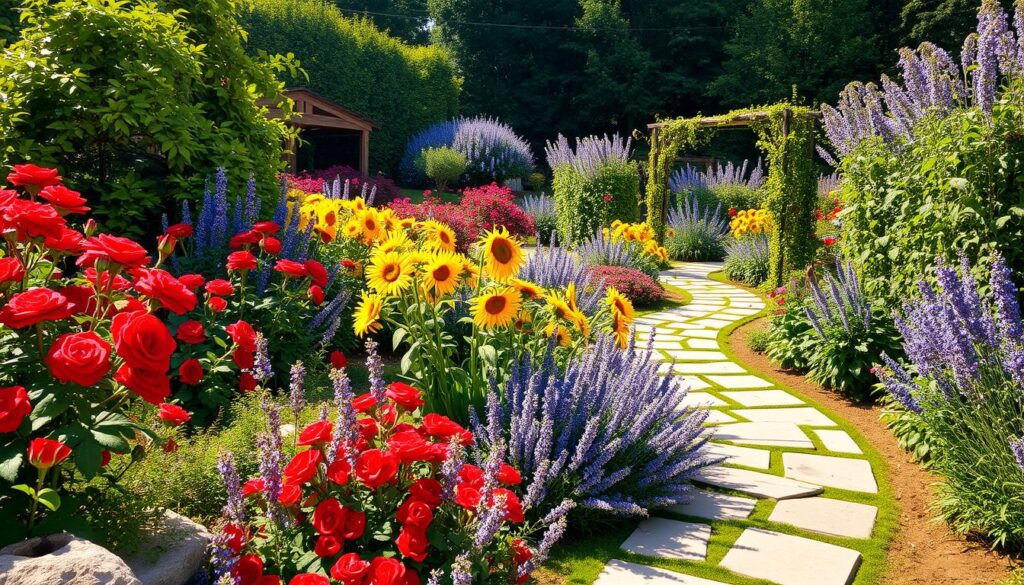
Resources like the Royal Horticultural Society (RHS) website and Gardener’s World magazine have been invaluable. They provide expert advice and inspiration, helping me refine my skills and avoid common mistakes. Gardening is a journey, and every step brings new lessons and rewards.
Here’s a quick guide to wildlife-friendly practices:
| Feature | Benefit |
|---|---|
| Native Plants | Support local wildlife and require less maintenance. |
| Ponds | Attract frogs, birds, and beneficial insects. |
| Bird Feeders | Encourage bird visits and add life to your space. |
| Compost Piles | Recycle organic waste and enrich soil naturally. |
With time and effort, your outdoor space can become a sanctuary for both you and nature. Embrace the process, and enjoy the transformation.
Understanding Your Garden Space
Understanding your outdoor space is the foundation of a thriving yard. Before diving into plant selection or layout ideas, take time to assess the unique characteristics of your area. This step ensures every decision aligns with the natural features of your space.
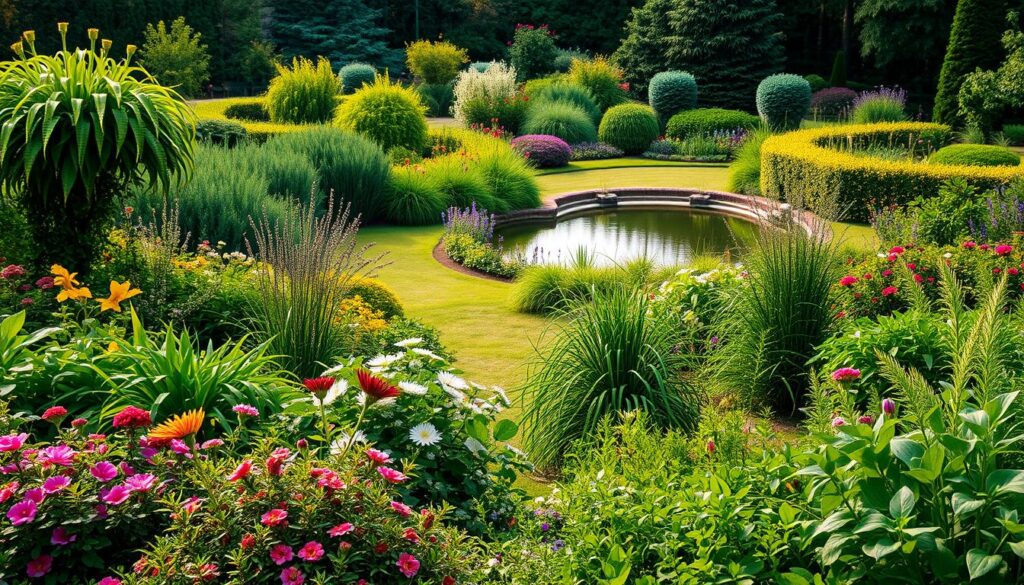
Assessing the Size and Shape
Start by measuring the dimensions of your yard. For example, a 6m x 16m L-shaped space offers both opportunities and challenges. Use a smartphone compass app to determine the aspect of your garden. This tool helps identify which areas receive the most sunlight and which remain shaded.
Microclimates can vary significantly within a single space. A sunny corner might support heat-loving plants, while a shaded area could be perfect for ferns or hostas. Document these variations in sketches for future reference.
Tracking Sun and Shade Patterns
Sun mapping is essential for understanding light distribution. Observe your space at different times of the day. Morning sun might warm one side, while afternoon shade cools another. These patterns influence plant choices and placement.
Wind exposure also plays a role. Urban settings often have less wind, while rural areas might experience stronger gusts. Consider these factors when planning layouts or selecting plants.
By documenting your findings, you create a valuable reference for future projects. Sketches or notes on sun, shade, and wind patterns ensure every decision is informed and intentional.
Sketching Your Garden Design
A well-drawn sketch can transform your ideas into a clear and actionable layout. It’s a simple yet powerful tool that helps you visualize your space and make informed decisions. You don’t need artistic skills—just a pencil, paper, and a willingness to experiment.
Start by marking permanent features like patios, trees, and utility lines. These elements shape your design and ensure your layout works with existing structures. Use basic shapes to represent each feature, keeping the sketch simple and functional.
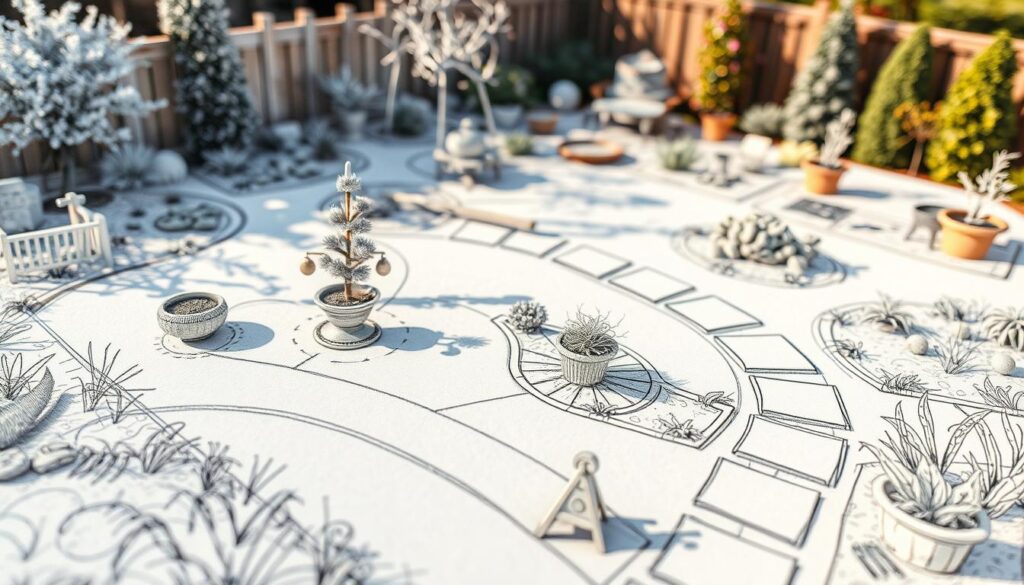
Next, incorporate aspect information into your drawing. Note areas with full sun, partial shade, or full shade. This step ensures your plant choices align with the natural conditions of your space. Accurate sun mapping prevents costly mistakes and enhances plant health.
Experiment with different layouts by creating multiple sketches. Move elements around to see what works best. For example, transforming a vegetable patch into a play area can be as simple as revising your sketch.
“A sketch is a playground for ideas—don’t be afraid to explore.”
Here’s a quick guide to essential sketch elements:
| Element | Purpose |
|---|---|
| Permanent Features | Identify fixed structures and utilities. |
| Sun/Shade Areas | Guide plant placement and growth. |
| Proposed Layouts | Experiment with design ideas. |
| Scale Measurements | Ensure accurate proportions. |
By sketching your ideas, you create a roadmap for your project. It’s a flexible tool that evolves with your vision, ensuring your space reflects your goals and lifestyle.
Zoning Your Garden
Dividing your outdoor space into zones can maximize its functionality and beauty. By creating distinct areas, you ensure every part of your yard serves a purpose. Whether it’s a cozy reading nook or a vibrant vegetable patch, zoning helps you make the most of your space.

Creating Functional Areas
A well-zoned layout includes spaces for different activities. For example, a sunny patio can double as a BBQ area and a quiet retreat. A lawn provides room for play, while a potting zone keeps gardening tools organized. Multi-functional zoning ensures your space adapts to your needs.
Transitional planning is key for evolving family needs. Design areas that grow with your family, from child-friendly play zones to adult relaxation spots. This approach keeps your space relevant and enjoyable for years to come.
Incorporating Wildlife-Friendly Features
Adding wildlife-friendly elements enhances your space and supports local ecosystems. A small pond attracts frogs, birds, and beneficial insects. Ensure safety by using shallow designs or protective barriers for families with children.
Chemical-free maintenance strategies keep your space healthy for both plants and wildlife. Use natural compost and avoid harmful pesticides. Native plants are a great choice—they require less care and support local species.
| Zone | Purpose |
|---|---|
| Potting Area | Organize tools and grow seedlings. |
| Dining Space | Host meals and gatherings. |
| Lawn | Provide room for play and relaxation. |
| Sunny Patio | Serve as a BBQ spot or reading nook. |
| Vegetable/Play Area | Grow food or create a child-friendly zone. |
By zoning your space thoughtfully, you create a yard that’s both functional and inviting. For more tips on starting your outdoor journey, check out this beginner’s guide. Embrace the process, and enjoy the transformation.
Choosing the Right Plants
Selecting the right plants for your outdoor space can make all the difference. The key to success lies in understanding your environment and matching it with suitable species. This ensures your space stays vibrant, healthy, and easy to maintain.
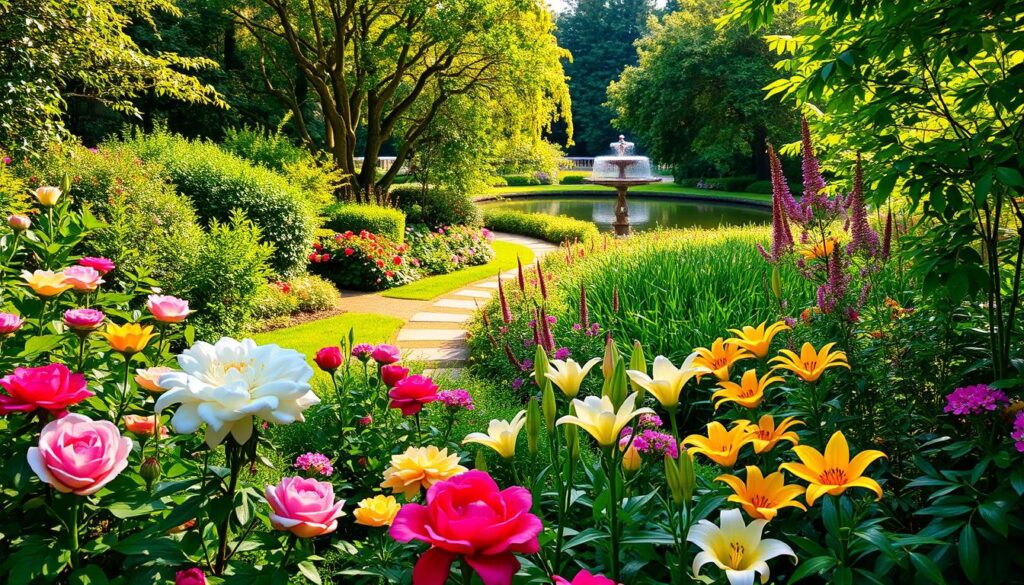
Selecting Plants Based on Soil Type
Soil plays a crucial role in plant health. Start by testing your soil’s pH level. For example, blueberries thrive in acidic soil, while rhododendrons prefer slightly acidic conditions. The Royal Horticultural Society (RHS) offers simple testing methods to help you get started.
If you have clay soil, mulching can improve its structure. A success story involves adding organic mulch to clay soil, which enhanced drainage and nutrient availability. For problematic soils, consider container gardening. It allows you to control the soil type and ensures your plants thrive.
Considering Water Needs
Water requirements vary widely among plants. Hydrangeas, for instance, need consistent moisture, while Mediterranean herbs like rosemary prefer drier conditions. A water needs matrix can help you group plants with similar requirements, making maintenance easier.
Rainwater harvesting is an eco-friendly solution. Integrated butt systems collect and store rainwater, reducing reliance on tap water. This approach is especially useful during dry spells.
Here’s a quick guide to plant selection based on soil and water needs:
| Plant | Soil Type | Water Needs |
|---|---|---|
| Blueberries | Acidic | Moderate |
| Rosemary | Well-drained | Low |
| Hydrangeas | Moist, fertile | High |
| Rhododendrons | Slightly acidic | Moderate |
Succession planting is another strategy to consider. It ensures continuous harvests by staggering plantings throughout the season. For example, follow early-season lettuce with late-season beans. This approach maximizes space and keeps your yard productive year-round.
Designing with Trees and Shrubs
Trees and shrubs bring structure and beauty to any outdoor area. They create focal points, provide shade, and enhance the overall aesthetic. Whether you have a compact yard or a sprawling space, these elements can transform your environment.
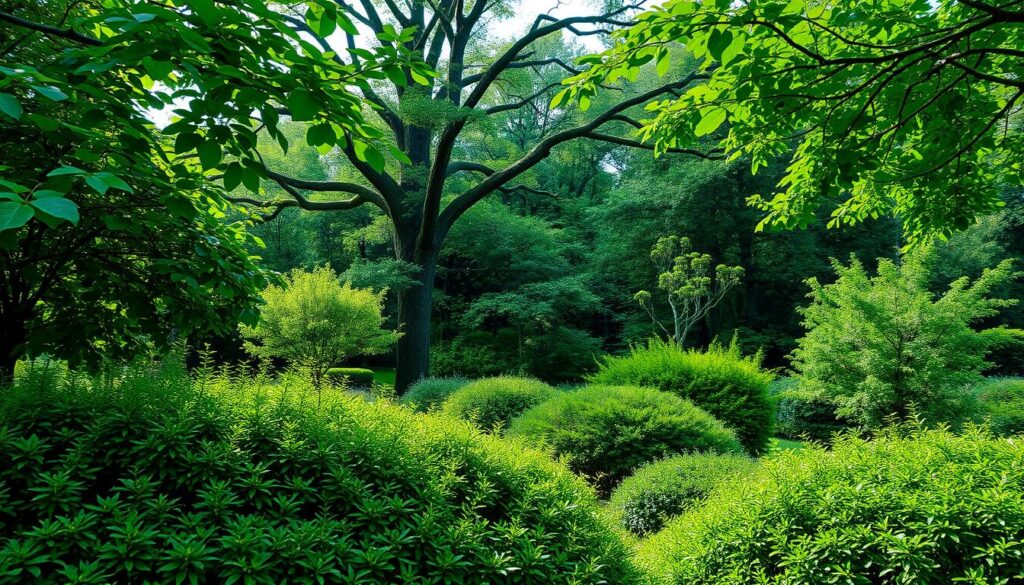
For smaller spaces, dwarf varieties are ideal. Japanese maples and potted olive trees add elegance without overwhelming the area. These compact options fit seamlessly into tight corners or container setups.
Combining evergreen and deciduous plants ensures year-round interest. Evergreens like boxwood provide consistent greenery, while deciduous trees like acers offer seasonal color changes. This mix keeps your space vibrant throughout the year.
Strategic placement of trees can manage shade effectively. For example, planting a tree on the west side of your yard can block harsh afternoon sun. This creates a cooler, more comfortable space for relaxation.
Low-maintenance shrubs are perfect for busy homeowners. Lavender and hydrangeas require minimal care and thrive in various conditions. These options add beauty without demanding constant attention.
Creative solutions, like a movable Christmas spruce in a container, add flexibility. You can reposition the tree for seasonal celebrations or aesthetic changes. This approach keeps your space dynamic and adaptable.
| Plant Type | Benefit |
|---|---|
| Dwarf Trees | Ideal for small spaces, easy to maintain. |
| Evergreen Shrubs | Provide year-round greenery and structure. |
| Deciduous Trees | Offer seasonal color and shade management. |
| Low-Maintenance Shrubs | Require minimal care, thrive in various conditions. |
| Movable Container Trees | Add flexibility for seasonal or aesthetic changes. |
By thoughtfully incorporating trees and shrubs, you can create a balanced and inviting outdoor area. These elements not only enhance the beauty of your space but also contribute to its functionality and charm.
Incorporating Raised Beds and Containers
Raised beds and containers offer flexibility and efficiency for any outdoor project. They provide better soil control, improved drainage, and easier access for planting and maintenance. Whether you’re working with limited space or looking to enhance your layout, these solutions are versatile and practical.
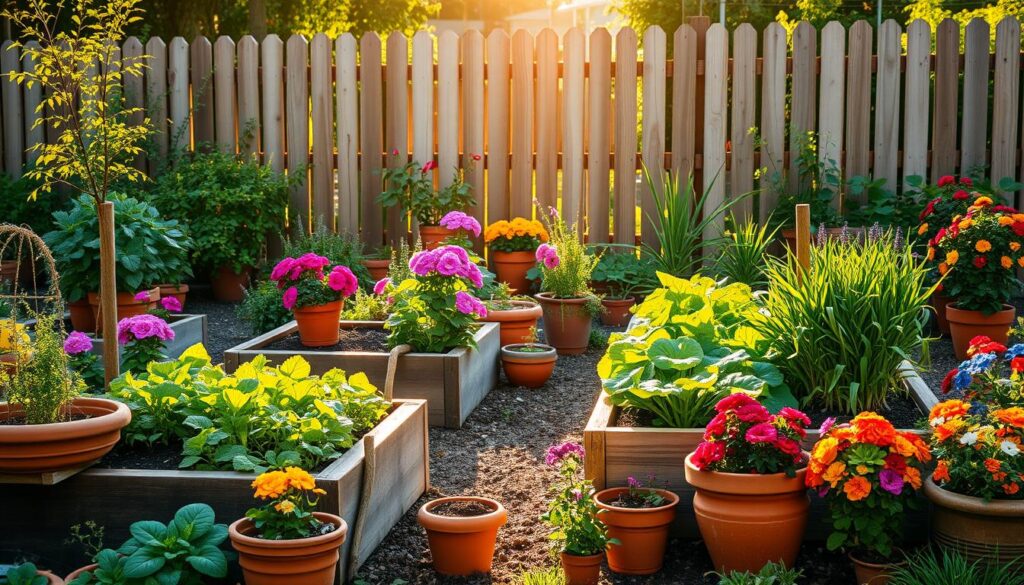
Material comparisons are essential when choosing raised beds. Wood is a popular choice for its natural look and affordability. Metal beds are durable and modern, while stone offers a timeless aesthetic. Each material has its benefits, so consider your budget and style preferences.
Square-foot gardening templates maximize yield in small spaces. By dividing a raised bed into sections, you can grow a variety of plants efficiently. This method reduces waste and ensures every inch of your space is productive.
Containers are ideal for renters or those with changing needs. They’re portable, allowing you to move plants as needed. This flexibility is perfect for experimenting with layouts or adapting to seasonal changes.
Soil customization is another advantage of raised beds and containers. You can tailor the soil mix to suit specific plants, ensuring optimal growth. For example, vegetables thrive in nutrient-rich soil, while succulents prefer well-draining mixes.
Vertical integration with trellis systems adds another layer of functionality. Climbing plants like beans or cucumbers can grow upward, saving ground space. This approach is especially useful in compact areas.
| Feature | Benefit |
|---|---|
| Wood Beds | Natural look, affordable, easy to assemble. |
| Metal Beds | Durable, modern, long-lasting. |
| Stone Beds | Timeless aesthetic, sturdy, low maintenance. |
| Containers | Portable, adaptable, space-efficient. |
By incorporating raised beds and containers, you create a functional and organized outdoor space. These solutions are adaptable, making them suitable for any project or lifestyle.
Adding Hardscaping Elements
Hardscaping elements can elevate the functionality and aesthetics of your outdoor space. From patios to fences, these features provide structure and enhance the overall appeal of your yard. They also create defined areas for relaxation, entertainment, and practical use.
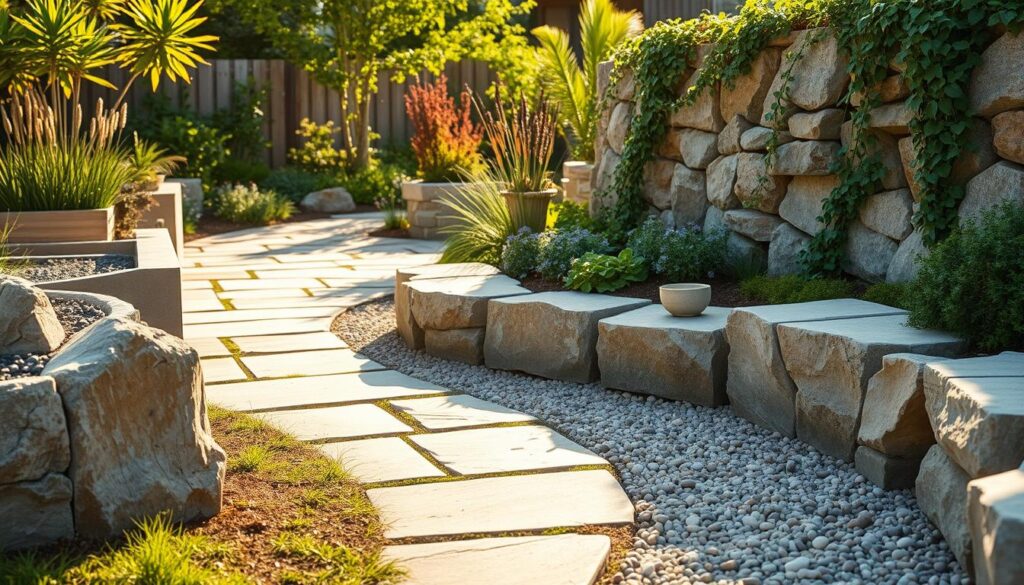
Patios and Walkways
Patios are a versatile addition to any outdoor area. They serve as a foundation for seating, dining, or hosting gatherings. When choosing materials, consider cost, durability, and style. Gravel is affordable and easy to install, while pavers offer a polished look. Poured concrete is durable but may require professional installation.
Walkways connect different zones in your yard. Integrating drainage solutions prevents water pooling and ensures longevity. For example, sloped designs or permeable materials like gravel allow water to flow naturally. This approach keeps your space functional and visually appealing.
Fences and Walls
Fences provide privacy and security while adding character to your space. Painting your fence with products like Cuprinol Muted Clay enhances its appearance and protects it from weathering. Regular maintenance ensures it stays vibrant and durable.
Walls can serve multiple purposes. Built-in seating or storage options maximize functionality. For example, a low wall with integrated benches creates a cozy seating area. Weather-resistant materials like stone or treated wood ensure longevity in different climates.
| Feature | Material | Benefit |
|---|---|---|
| Patio | Gravel, Pavers, Concrete | Durable, versatile, stylish |
| Walkway | Permeable materials | Prevents water pooling, functional |
| Fence | Treated wood, Metal | Privacy, security, aesthetic |
| Wall | Stone, Treated wood | Multi-functional, weather-resistant |
By thoughtfully incorporating hardscaping elements, you create a cohesive and inviting outdoor space. These features not only enhance the beauty of your yard but also improve its functionality and longevity.
Planning for Seasonal Changes
Adapting your outdoor space to the changing seasons ensures year-round beauty. A thoughtful approach keeps your area vibrant and functional, no matter the time of year. From plant rotations to structural elements, every detail matters.
Start with a four-season rotation schedule for your plants. Spring bulbs, summer blooms, fall foliage, and winter evergreens create continuous interest. This strategy ensures your space remains lively and engaging throughout the year.
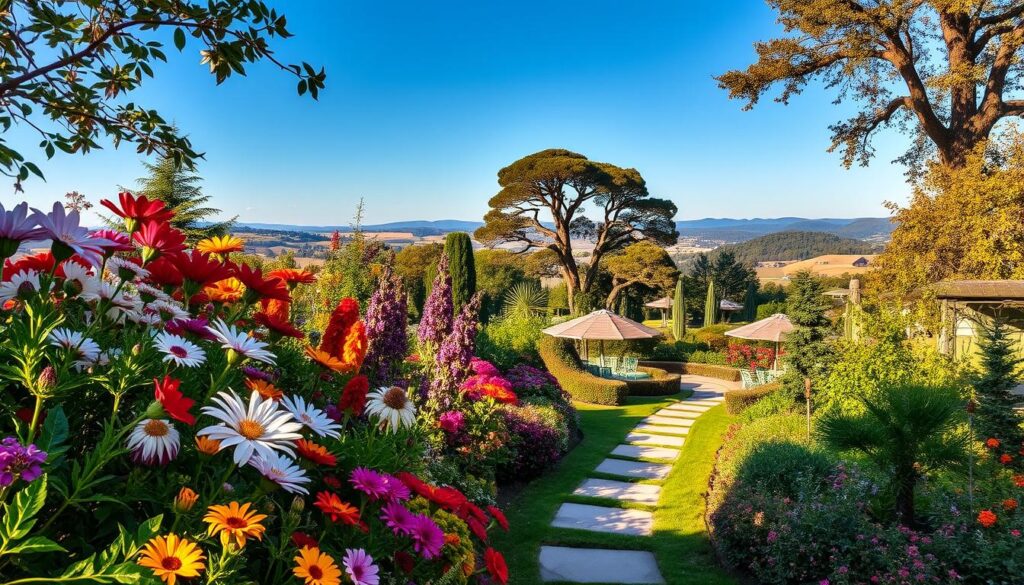
Structural elements like arbors and trellises add winter interest. They provide a framework for climbing plants and create visual appeal even when flowers aren’t in bloom. Integrating holiday lighting into these structures enhances their functionality and festive charm.
Frost protection is essential for container plants. Use mulch, frost cloths, or move containers to sheltered areas during cold snaps. These methods safeguard your plants and extend their lifespan.
Succession planting keeps your space colorful year-round. Plan a calendar to stagger plantings, ensuring continuous blooms and harvests. For example, follow early-season lettuce with late-season beans for a seamless transition.
By planning for seasonal changes, you create a dynamic and inviting outdoor space. Embrace the rhythm of the seasons, and enjoy the beauty they bring to your area.
Finalizing Your Garden Layout
Finalizing your outdoor layout is the key to a cohesive and functional space. A phased approach ensures every element works together seamlessly. Start with landscaping features like patios and walkways, then move to planting. This method prevents disruptions and keeps your project organized.
Utility planning is essential for a smooth layout. Consider lighting, irrigation, and access points early in the process. Here’s a quick checklist to guide you:
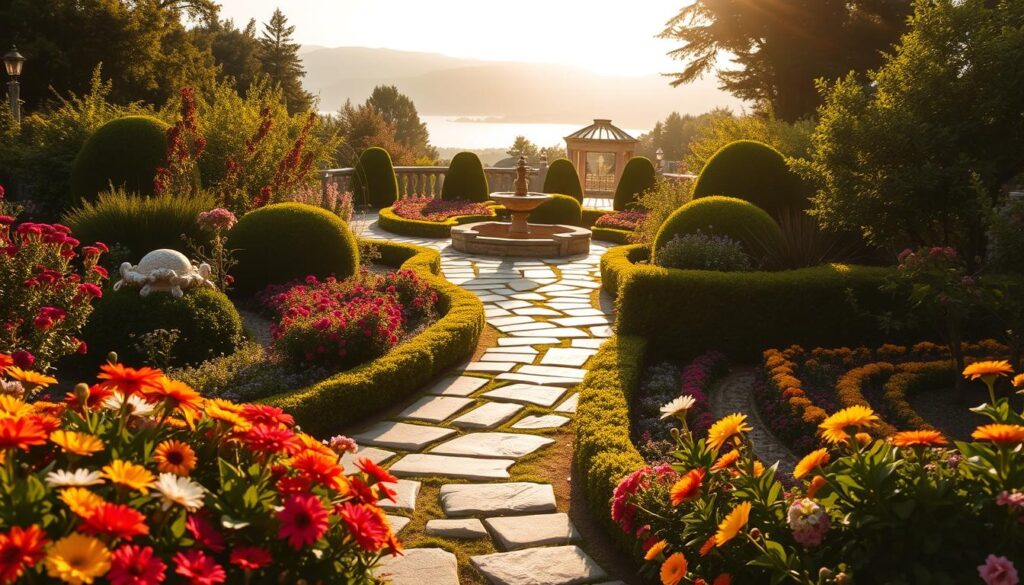
| Utility | Considerations |
|---|---|
| Lighting | Plan for pathways, seating areas, and security. |
| Irrigation | Install drip systems or sprinklers for efficient watering. |
| Access | Ensure pathways are wide enough for tools and movement. |
Accommodating growth is another critical step. Mature plants need more space, so avoid overcrowding. Budget-friendly staging with annuals as fillers adds color while permanent plants establish themselves. This approach keeps your space vibrant without overspending.
Common layout mistakes include ignoring sun patterns or underestimating plant size. For example, placing a shade-loving plant in full sun can lead to failure. Learn from these errors to refine your design.
When choosing tools, weigh professional options against DIY solutions. Professional tools offer precision but can be costly. DIY methods are budget-friendly but may require more effort. Choose what fits your skills and resources.
By finalizing your layout thoughtfully, you create a space that’s both beautiful and functional. Every detail, from utilities to plant placement, contributes to a harmonious outdoor area.
Conclusion
Every outdoor space holds the potential to reflect your unique style and needs. By focusing on observation, zoning, and plant selection, you can create a garden that thrives. Experimentation is key—try new layouts or plants to see what works best for your area.
For inspiration, explore resources from experts like Adam Frost and Monty Don. Their insights can guide you in crafting a design that’s both beautiful and functional. Remember, sustainability matters. Avoid plastic features and opt for eco-friendly choices that benefit your space and the environment.
Share your progress photos with others. Your journey can inspire fellow enthusiasts and create a community of shared learning. Your outdoor garden is more than a project—it’s a reflection of your creativity and care.

